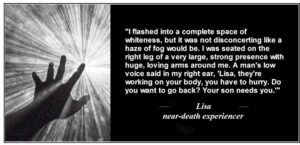This site uses affiliate links to Amazon.com Books for which IANDS can earn an affiliate commission if you click on those links and make purchases through them.
1. Introduction to Temporal Lobe Epilepsy and NDEs
Temporal lobe epilepsy (TLE), a neurological condition that affects the brain’s temporal lobes, has been identified as a possible trigger for near-death experiences (NDEs) or NDE-like phenomena. Individuals with TLE sometimes report mystical or transcendental experiences during seizures, which bear striking similarities to the classic features of NDEs, such as out-of-body experiences, feelings of euphoria, vivid visions, and encounters with spiritual entities or a sense of the divine.
The temporal lobes play a crucial role in processing emotions, memories, and sensory input, and they are closely linked to the brain’s management of consciousness and perception. During seizures, abnormal electrical activity in these areas can create intense altered states of consciousness that resemble NDEs. Some researchers propose that these episodes may give insight into how the brain processes experiences of life, death, and spirituality, potentially explaining why people undergoing actual near-death events report similar sensations.
The connection between TLE and NDEs suggests that the brain’s wiring may be involved in generating profound mystical or transcendental experiences, even in the absence of a life-threatening event. This link raises intriguing questions about the nature of NDEs, whether they are purely neurological in origin or if they point to a deeper, non-material dimension of consciousness. Understanding the relationship between TLE and NDEs offers valuable insights into how the brain functions during extreme states of consciousness.
Scientists researching the brain have examined the experiences of people suffering from temporal lobe epilepsy. Apparently the increased electrical activity in the brain resulting from seizure activity (abnormal electrical activity in the brain), makes sufferers more susceptible to having near-death experiences. This gives cause for researchers to examine the temporal area of the brain, the portion of the brain that researchers refer to as the God Spot.
2. Lisa’s NDE
The following near-death experience happened three years ago to a woman named Lisa and was triggered by seizure. After months of depression and physical pain from systemic lupus, one day she took too many painkillers. Her twin sister found her in the morning in a seizure, half-flopped off of her bed. By the time she called 911, she had fallen on the floor and was in a full convulsive state, curling up her hands in a fetal position. Here is what she experienced in her own words:
There was no tunnel or light. I awoke standing upright in the back of what looked like a large auditorium-type place, without the chairs. The wall were gold and had jewels embedded in them. I was far in the back at first and couldn’t figure out where I was. There were horns playing loud classical-type music and it was a very formal-type ceremony. There were dancers with beautifully colored flags dancing in a supernatural sort of way. I felt my presence coming in closer, but I didn’t feel legs moving underneath me.
There was a long, wide aisle with 10-15 men seated on each side of the aisle. They were across the aisle from each other, facing each other. They had on robes and gold crowns, like they were kings or judges. The seats were tall, gold chairs and at the end of the aisle was an empty chair. My presence came in very close and then to the left side came a man in a long, white, toga-type robe. He had short brown hair and on his head was a wreath of holly leaves woven together with baby’s breath. He smiled and approached me with his right hand extended.
He took my hand gently and said, “Hi, Lisa. I’m Peter, welcome to the festival.”
With that, he opened a large door and I entered a large place that was mostly white space. There were large white cloth-covered tables with beautiful, succulent fruit and a large fountain of red wine. There were just a few people there, and they were dressed in normal clothing of today.
Just then I flashed into a complete space of whiteness, but it was not disconcerting like a haze of fog would be. I was seated on the right leg of a very large, strong presence with huge, loving arms around me.
A man’s low voice said in my right ear, “Lisa, they’re working on your body, you have to hurry. Do you want to go back? Your son needs you.”
I remember feeling confused like I was not aware of what I had left behind.
I didn’t say anything and then the voice said louder, directly in my ear, “Lisa, you have to hurry, they’re working on your body. Do you want to go back?”
And even louder he added, “Ryan needs you.”
He put great stress on my son’s name. I immediately realized I had left my 9-year-old son behind and then I woke up in the ambulance. They later told me that I said, “I wanted to be in paradise with Jesus“.
That’s my experience. I’d love to hear your comments. I’ve not read anything like this before. It was like a movie, almost sounds cliche, I know.
3. Dr. Sam Parnia’s Research
A British scientist Sam Parnia, studying heart attack patients says he is finding evidence that suggests that consciousness may continue after the brain has stopped functioning and a patient is clinically dead. The research, presented to scientists last week at the California Institute of Technology, resurrects the debate over whether there is life after death and whether there is such a thing as the human soul.
Since the initial experiment, Parnia and his colleagues have found more than 3,500 people with lucid memories that apparently occurred at times they were thought to be clinically dead. Many of the patients, he said, were reluctant to share their experiences fearing they would be thought crazy.
One patient was 2 years old when he had a seizure and his heart stopped. His parents contacted Parnia after the boy drew a picture of himself as if out of his body looking down at himself.
It was drawn like there was a balloon stuck to him. When they asked what the balloon was he said:
“When you die you see a bright light and you are connected to a cord.”
He wasn’t even three-years old when had the experience.
What his parents noticed was that after he had been discharged from hospital, six months after the incident, he kept drawing the same scene.
The brain function that these patients were found to have while unconscious is commonly believed to be incapable of sustaining lucid thought processes or allowing lasting memories to form, Parnia said – pointing to the fact that nobody fully grasps how the brain generates thoughts.













